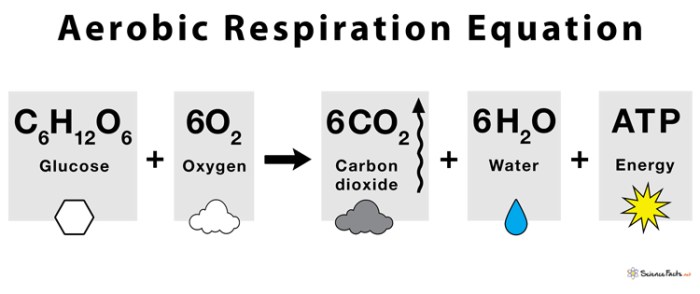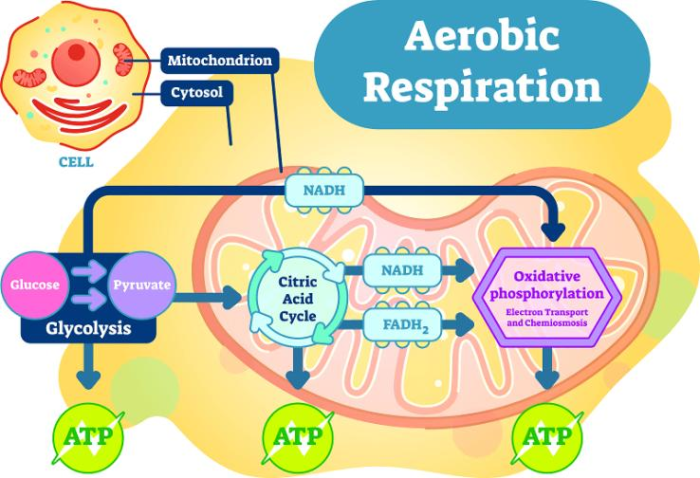Aerobic respiration section 7-2 review – Embark on an in-depth exploration of aerobic respiration with our comprehensive review of Section 7-2. Delve into the intricate mechanisms of this vital process, uncovering its significance for energy production and cellular well-being.
Our journey begins with a thorough examination of the Krebs cycle, where we unravel the intricate dance of enzymes and energy yield. We then delve into the electron transport chain, deciphering its role in generating the cellular powerhouse, ATP.
Overview of Aerobic Respiration

Aerobic respiration is a metabolic process that uses oxygen to convert glucose into carbon dioxide and water, releasing energy in the form of ATP.
Oxygen serves as the final electron acceptor in the electron transport chain, enabling the efficient transfer of electrons and the generation of a proton gradient that drives ATP synthesis.
The overall equation for aerobic respiration is: C 6H 12O 6+ 6O 2→ 6CO 2+ 6H 2O + energy (as ATP)
Glycolysis
Glycolysis is the first stage of aerobic respiration, occurring in the cytoplasm.
Key enzymes involved in glycolysis include hexokinase, phosphofructokinase, and pyruvate kinase.
The net energy yield of glycolysis is 2 molecules of ATP and 2 molecules of NADH.
Krebs Cycle
The Krebs cycle, also known as the citric acid cycle, takes place in the mitochondrial matrix.
Key enzymes involved in the Krebs cycle include citrate synthase, isocitrate dehydrogenase, and α-ketoglutarate dehydrogenase.
The net energy yield of the Krebs cycle is 2 molecules of ATP, 6 molecules of NADH, and 2 molecules of FADH 2.
Electron Transport Chain
The electron transport chain is located in the inner mitochondrial membrane.
Key enzymes involved in the electron transport chain include NADH dehydrogenase, cytochrome c oxidase, and ATP synthase.
The net energy yield of the electron transport chain is 32-34 molecules of ATP.
ATP Production
ATP synthase is an enzyme that uses the proton gradient generated by the electron transport chain to produce ATP from ADP and inorganic phosphate.
The chemiosmotic theory of ATP production explains how the proton gradient drives the synthesis of ATP.
Factors that affect the rate of ATP production include the availability of oxygen, the concentration of ADP and inorganic phosphate, and the presence of inhibitors.
Regulation of Aerobic Respiration
Aerobic respiration is regulated by hormonal signals, feedback inhibition, and oxygen concentration.
Hormones such as insulin and glucagon can stimulate or inhibit aerobic respiration.
Feedback inhibition occurs when the end products of a metabolic pathway inhibit the enzymes involved in the pathway.
Oxygen concentration affects the rate of aerobic respiration, with higher oxygen levels leading to increased ATP production.
Importance of Aerobic Respiration, Aerobic respiration section 7-2 review
Aerobic respiration is crucial for energy production, providing the majority of ATP used by cells.
Aerobic respiration also plays a role in maintaining cellular homeostasis by generating reducing equivalents (NADH and FADH 2) that can be used in other metabolic processes.
Impaired aerobic respiration can lead to a variety of cellular and systemic dysfunctions.
Popular Questions: Aerobic Respiration Section 7-2 Review
What is the primary role of aerobic respiration?
Aerobic respiration serves as the primary energy source for most organisms, converting glucose into ATP to fuel cellular activities.
Explain the significance of the electron transport chain in aerobic respiration.
The electron transport chain plays a crucial role in generating the proton gradient used to drive ATP synthesis through chemiosmosis.
How does feedback inhibition regulate aerobic respiration?
Feedback inhibition occurs when the end product of a metabolic pathway inhibits an earlier step, preventing overproduction.


